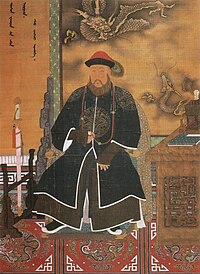Dorgon
| Dorgon | |||||||||||||
|---|---|---|---|---|---|---|---|---|---|---|---|---|---|
| Prince Rui of the First Rank | |||||||||||||

Portrait of Dorgon
|
|||||||||||||
| Prince Rui of the First Rank | |||||||||||||
| Reign | 1636–1650 | ||||||||||||
| Predecessor | None | ||||||||||||
| Successor | Chunying | ||||||||||||
| Born |
17 November 1612 Yenden (present-day Xinbin Manchu Autonomous County, Fushun, Liaoning) |
||||||||||||
| Died | 31 December 1650 (aged 38) Kharahotun (present-day Chengde, Hebei) |
||||||||||||
| Spouse |
Primary spouses: Lady Borjigit Lady Tunggiya Lady Borjigit Lady Borjigit Lady Borjigit Yi Ae-suk Secondary spouses: Lady Gongqite Lady Borjigit Lady Ji'ermote Lady Yi |
||||||||||||
| Issue | Donggo (daughter) Dorbo (adopted son) |
||||||||||||
|
|||||||||||||
| House | Aisin Gioro | ||||||||||||
| Father | Nurhaci | ||||||||||||
| Mother | Lady Abahai | ||||||||||||
| Full name | |
|---|---|
| Aisin-Gioro Dorgon (愛新覺羅·多爾袞) |
|
| Posthumous name | |
| 1. Emperor Yi (Chinese: 義皇帝) (revoked in 1651) 2. Prince Ruizhong of the First Rank (和碩睿忠親王) (granted in 1778) |
|
| Temple name | |
| Emperor Chengzong of Qing (清成宗) (revoked in 1651) |
| Dorgon | |||||||
| Chinese name | |||||||
|---|---|---|---|---|---|---|---|
| Traditional Chinese | 多爾袞 | ||||||
| Simplified Chinese | 多尔衮 | ||||||
|
|||||||
| Manchu script name | |||||||
| Manchu script | ᡩᠣᡵᡤᠣᠨ | ||||||
| Transcription name | |||||||
| Transcription | Dorgon | ||||||
| Transcriptions | |
|---|---|
| Standard Mandarin | |
| Hanyu Pinyin | Duō'ěrgǔn |
Dorgon (Manchu: ![]() , literally "badger"; 17 November 1612 – 31 December 1650), formally known as Prince Rui, was a Manchu prince and regent of the early Qing dynasty. Born in the Aisin Gioro clan as the 14th son of Nurhaci (the founder of the Qing dynasty), Dorgon started his career in military campaigns against the Ming dynasty, Mongols and Koreans during the reign of his eighth brother, Huangtaiji, who succeeded their father. After Huangtaiji's death in 1643, he was involved in a power struggle against Huangtaiji's eldest son, Hooge, over the succession to the throne. Both of them eventually came to a compromise by backing out and letting Huangtaiji's ninth son, Fulin, become the emperor; Fulin was installed on the throne as the Shunzhi Emperor. Dorgon served as Prince-Regent from 1643–1650, throughout the Shunzhi Emperor's early reign. In 1645, he was given the honorary title "Emperor's Uncle and Prince-Regent"; the title was changed to "Emperor's Father and Prince-Regent" in 1649. Under Dorgon's regency, Qing forces occupied Beijing, the capital of the fallen Ming dynasty, and gradually conquered the rest of China in a series of battles against Ming loyalists and other opposing forces around China. Dorgon also introduced the policy of forcing all Han Chinese men to shave the front of the heads and wear their hair in queues just like the Manchus. He died in 1650 during a hunting trip and was posthumously honoured as an emperor even though he was never an emperor during his lifetime. However, a year after Dorgon's death, the Shunzhi Emperor accused Dorgon of several crimes, stripped him of his titles, and ordered his remains to be exhumed and flogged in public. Dorgon was posthumously rehabilitated and restored of his honorary titles by the Qianlong Emperor in 1778.
, literally "badger"; 17 November 1612 – 31 December 1650), formally known as Prince Rui, was a Manchu prince and regent of the early Qing dynasty. Born in the Aisin Gioro clan as the 14th son of Nurhaci (the founder of the Qing dynasty), Dorgon started his career in military campaigns against the Ming dynasty, Mongols and Koreans during the reign of his eighth brother, Huangtaiji, who succeeded their father. After Huangtaiji's death in 1643, he was involved in a power struggle against Huangtaiji's eldest son, Hooge, over the succession to the throne. Both of them eventually came to a compromise by backing out and letting Huangtaiji's ninth son, Fulin, become the emperor; Fulin was installed on the throne as the Shunzhi Emperor. Dorgon served as Prince-Regent from 1643–1650, throughout the Shunzhi Emperor's early reign. In 1645, he was given the honorary title "Emperor's Uncle and Prince-Regent"; the title was changed to "Emperor's Father and Prince-Regent" in 1649. Under Dorgon's regency, Qing forces occupied Beijing, the capital of the fallen Ming dynasty, and gradually conquered the rest of China in a series of battles against Ming loyalists and other opposing forces around China. Dorgon also introduced the policy of forcing all Han Chinese men to shave the front of the heads and wear their hair in queues just like the Manchus. He died in 1650 during a hunting trip and was posthumously honoured as an emperor even though he was never an emperor during his lifetime. However, a year after Dorgon's death, the Shunzhi Emperor accused Dorgon of several crimes, stripped him of his titles, and ordered his remains to be exhumed and flogged in public. Dorgon was posthumously rehabilitated and restored of his honorary titles by the Qianlong Emperor in 1778.
...
Wikipedia
